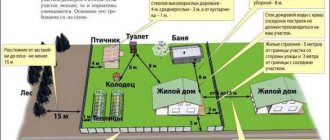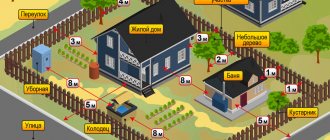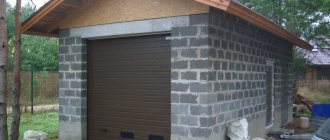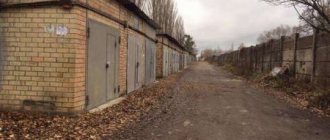Violation of SNIP 2.07.01-89 and SNIP 21-01-97 does not imply administrative or criminal liability for the owner of the garage premises.
Dear readers! The article talks about typical ways to resolve legal issues, but each case is individual. If you want to find out how to solve your particular problem , contact a consultant:
+7 (499) 110-56-12 (Moscow)
+7 (812) 317-50-97 (Saint Petersburg)
8 (800) 222-69-48 (Regions)
APPLICATIONS AND CALLS ARE ACCEPTED 24/7 and 7 days a week.
It's fast and FREE !
This is explained by the fact that the requirements contained in them are advisory in nature.
However, when building a private garage, SNIP standards must be taken into account; this will ensure the reliability of the structure and its fire safety.
Categories of objects by fire hazard
Taking into account the explosion and fire hazard, parking lots and garages for passenger cars are divided into several categories:
- Category 1 - these are individual garages that are private property; they are not necessarily classified according to explosion hazard, unless they are used as a service station;
- Category 2 - private garages of the GSK (garage construction cooperative), such structures are equated to a warehouse where flammable materials are stored, therefore explosion and fire hazard calculations are mandatory;
- Category 3 - underground parking lots, devices for automatic fire extinguishing must be installed in them, each level must be equipped with a special box with personal protective equipment and fire extinguishing equipment;
- garage boxes - they are subject to safety requirements depending on the established degree of explosion and fire hazard, as well as the fuel used, and a person responsible for fire safety is appointed (conducts instructions).
In garage boxes, depending on what class the building belongs to, a manual or automatic fire extinguishing system is installed.
- The room where more than 30 cars are parked is equipped with a fire alarm; at the design stage of the building, the requirements for car evacuation are taken into account.
- There must be enough space for two cars to pass each other.
What size should the building be?
The size of the garage depends on several parameters:
- number of cars;
- car size;
- additional garage functions;
- area of land;
- personal wishes of the owner.
The standard size for 1 car is 3x6 m with a height of 1.8 to 2.2 m, while the width of the gate should be 2.5 m.
If you plan to purchase a larger car in the future, then this should definitely be taken into account when building a garage.
The optimal garage size is determined based on the area of the land plot.
But a space that is too cramped will require masterful parking skills, and the construction of a large garage involves additional costs.
Even before construction begins, at the design stage you should carefully consider every little detail:
- racks for storing tools, car care products and spare parts;
- a workbench required for minor repairs;
- additional household needs.
- The optimal width of passages is at least 1 m, the ceiling should be at least half a meter higher than a person’s height. To install shelves, you need to add at least one meter to the length of the aisle.
- The width of the building should be approximately 0.8 m greater than the width of the car.
- The optimal length of the garage is one and a half times the length of the car. Depending on your own preferences, the structure can be made more spacious.
Most often you can find garages with an area of 5x7 m, this is explained by the fact that the owners tend to equip it with racks and shelves. If you increase the length of the building, then in addition to the parking space, you can equip another room.
The design of the garage must be carried out in accordance with the document dated January 21, 1997, “Fire Safety Rules for Buildings and Structures.”
An individual detached or attached garage is being built in accordance with SNiP 2.07.01-89 “Urban Planning. Planning and development of urban and rural settlements.”
It should be kept in mind that the larger the garage, the more expensive it will cost to build.
Standards for indentation from the garage to the fence
The ideal solution when planning the construction of a fence between neighboring plots is a meeting of owners whose houses are located on adjacent land. The result is an act of approval of boundaries, which must contain an image of the plots with designated zones and buildings, as well as the signature of the owners who agree to the construction.
To avoid future misunderstandings and problems with the owner of the neighboring land, which is located behind the red fence line, you need to make the most accurate measurements before construction begins. This is explained by the fact that even a slight protrusion of the garage structure can become a reason for litigation.
26 Jan 2020 etolaw 1350
Share this post
- Related Posts
- Living wage in the absence of an indication in the Federal Law “On Enforcement Proceedings”
- Registered in the house but I don’t live there, can the bailiffs describe it?
- Pensioners of Federal Significance Who Are They?
- Benefits for an Orphan Child Under Guardianship 2020 in the Republic of Belarus
How to place a garage on a plot
- When starting the construction of a structure, it is necessary to take into account that the distance from the garage to the neighbor’s fence according to SNIP must be at least 1 m.
- From the veranda or windows of a house located on a neighboring site - no closer than 6 m.
On one site, a garage can be built as an extension to the house, but the following conditions must be met:
- the common wall between the house and the garage is built from non-combustible materials;
- the garage must be equipped with a fire alarm;
- the ideal gate option is roller shutter or sectional;
- a pitched roof makes building a garage cheaper.
Maintaining distance from other objects
Requirements regarding the construction of garages are contained in SNIP 2.07.01-89, but in a particular region, the local administration may additionally establish rules and regulations.
Violation of them will not entail administrative or criminal liability, since they are advisory in nature.
It should be remembered that there may be citizens who will not like the location of the garage. If in court they can prove a threat to health and life due to violation of requirements and standards, then the building will have to be demolished.
According to the rules, the minimum distances are:
- 6 m - the distance from the garage to the windows of the house located on the site next door (keeping the distance will ensure safety in the event of a fire - the fire will not be able to spread to the house if the garage catches fire);
- 3 m - the distance from a residential building to a garage located on the same site (there should be just such a distance around the house so that in the event of a fire, special equipment can drive up to it);
- 1 m - the distance from the border of the site to the garage (if there is a pedestrian path immediately behind the fence, then a car parked next to a gate placed in line with the fence will interfere with the movement of people);
- 1 m is the distance to the neighboring plot, that is, a fence behind which there may be beds or a garden (the building will create a shadow, in addition, it will be inconvenient to inspect the wall of the building from the neighbors).
Where to start registering the land under the garage as your property? How to draw up a preliminary agreement for the sale and purchase of a garage? Find out here.
Garages that have two floors have additional requirements:
- 5 m - there should be a distance from the garage to the red line (this will provide free access to communications located in the ground);
- 5 m - minimum distance from the garage door to the central road;
- 3 m - the distance from the edge of the road to the garage door in the side passage;
- 1 m - this should be the distance from the garage to any outbuilding.
The distance is measured from the basement of the garage, and if it is absent, you need to retreat from the walls. When the roof protrudes 0.5 m, the countdown is from its protection to the ground.
All of the above requirements apply only to garages, which are permanent buildings (built on a foundation).
Garages without a foundation, metal, concrete or frame garages are temporary structures and their location can be changed.
For this reason, when constructing such buildings, it is not necessary to take into account all the norms and requirements of SNIP.
The optimal ramp slope for entering an above-ground or underground garage is 25 degrees, the best ramp length is 5 m.
We study at what distance from the fence, neighboring plot, residential building you can build a garage
It is much easier to make this choice if the site is large , does not have low areas, is not directly adjacent to common utilities, and construction on adjacent sites is ongoing simultaneously. Then you don’t need to think about whether it’s possible to build a garage close to the fence. In this case, when choosing how to place a garage on the site, you can pay attention to the following options:
We recommend reading: Surgut cash compensation to honorary donors
When you are building a garage, you need to clarify the distance between the apartment building and the garage. After this, remember that the procedure for obtaining permission to develop a site, project approval, and notarization applies to all buildings, including the garage. After 3 years, the statute of limitations begins, after which claims against the development are no longer relevant.
SNIP requirements
Before starting construction, you should familiarize yourself with the two main SNIP garages:
- 07.01—89 — the requirements for structures used for storing cars are described;
- 21—01—97 — contains a list of rules for constructing a garage taking into account fire safety.
Knowledge and compliance with the requirements set out in these documents will ensure the reliability of the garage.
To ground closed type
The degree of fire resistance of closed above-ground garages is determined taking into account the size of the floors and the permissible number of storeys.
The first and second degrees of fire resistance include buildings with no more than nine floors.
The area between fire compartments on the ground floor of a one-story garage should not exceed 10.4 thousand m2. The floor area of a multi-storey building should not be more than 5.4 thousand m2.
The third degree of fire resistance includes garages with a floor area of 2.6 thousand m2, with such an area the height of the building is no more than five floors.
- If the garage is one-story, then the floor area is 5.2 thousand m2.
- Two-story garages with a floor area of 1.2 thousand m2 or one-story garages with a floor area of 3.6 thousand m2 belong to subcategory 3A.
Structures of the fourth degree of fire resistance include garages, which have 1 floor with an area of 2.6 thousand m2, and the fifth - one-story buildings up to 1.2 thousand m2.
For multi-storey garages that have half-frames (half-floors), the number of storeys is calculated by dividing the number of half-floors by two.
The level of fire resistance of garages located in private or single-family individual houses is not standardized.
In closed garages, it is necessary to separate fire compartments with special ceilings and walls, where the openings should be in the form of gates with doors.
To open
The degree of fire resistance of open garages is determined taking into account the area and number of floors:
- the first and second degrees of fire resistance include garages with no more than nine floors, on each of which the size of the fire compartment is 5.2 thousand m2;
- the third degree of fire resistance includes garages that have no more than six floors in height, the area of one floor is no more than 2.6 thousand m2;
- subcategory 3A includes garage premises that have a maximum of 3 floors with an area of each of them not exceeding 2 thousand m2; the structure of the building provides for the presence of a frame.
In open garages, it is prohibited to install boxes, as well as partitions and walls that impede the ventilation of the room. An exception to this rule is the wall of the landing.
Staircases must meet the requirements of the second degree of fire resistance.
- In open garages, it is allowed to install a mesh-type enclosing structure made of non-combustible materials, while the parapet can be no higher than one meter.
- Ventilation through residential buildings adjacent to the garage is prohibited.
To the underground
The degree of fire resistance of underground parking lots and garages is determined in accordance with their number of floors and area.
They belong to the first and second degree of fire resistance.
- Underground garages must be divided into fire-resistant compartments using special blind walls of type 1. In this case, the permitted number is up to 200 cars.
- Underground parking lots and garages must be at least 15 m away from the windows of kindergartens, schools, residential buildings, and medical institutions.
Distance from different types of objects
There are requirements for the distance of the garage from objects:
- from the entrance to the garage to the intersection of main roads should be approximately 5 m, the minimum distance from local streets is 2 m;
- there must be at least 3 m between the public stop and the entrance to the garage
- a service station and a car repair shop for 10 cars must be removed from an apartment building at a distance of at least 15 m; if the number of cars is larger, then the minimum distance is 25 m;
- parking (garage) for 10 cars should be located 10 m from residential buildings , if there are 11-50 cars, then the distance increases to 15 m at least, 50-100 cars - 25 m, 100-300 - 35 m;
- a garage for 50 cars should be located no closer than 10 m from a public building, if there are 100 cars, then the minimum distance should be 15 m, 300 - 25 m;
- the shortest distance from a garage for 10 cars to the hospital is 25 m, for 50 cars - 50 m;
- the distance of a garage for 10 cars from a kindergarten or school is 15 m; if the garage is designed for 100 cars, then the distance increases by at least 25 m; for 300 cars - 50 m.
SNiP for the construction of garages
To fill open openings in an external type of fence of this design, it is allowed to use a mesh. To reduce the influence of precipitation in open-type buildings, special canopies are made, but only non-combustible material is used. In this case, it is necessary to remember about draft ventilation on the floors. As for ventilation through residential structures adjacent to the garage, this is prohibited.
We recommend reading: Article 228 of the Criminal Code of the Russian Federation, all parts and paragraphs
1 mechanized garage block can accommodate no more than 100 vehicle spaces. If the room is composed of several such blocks, then between them it is necessary to make a separator with fire-fighting properties. It must belong to category 1 and have a fire resistance limit of at least 45 units for above-ground garages, and 150 units for underground garages. Each block is supposed to have a separate entrance for fire trucks.
Is it possible to break the rules?
In some cases, when constructing a garage, compliance with all SNIP requirements is impossible.
For example, you can reduce the distance between a house on a neighbors plot and a garage (in accordance with SNIP it should be at least 6 m).
There are no parking restrictions in front of a private house.
The only thing you should pay attention to is that the car should not block the passage and passage.
Reducing the distance between neighboring residential buildings
In order to reduce the distance between the garage and the house on the property next door, a special agreement will be required between the neighbors and the owner of the garage stating that they agree to reduce the distance. The contract must be renewed every 3 years.
In order to reduce the distance from the neighbor’s house to the garage, the following conditions must be met:
- It is necessary to install a box of sand and other fire-fighting equipment near the garage;
- presence of a fire extinguisher in the garage;
- lighting fixtures are equipped with protective shades;
- electrical wiring in the garage must fully comply with fire safety standards;
- Open heating equipment is prohibited;
- a private electrical line with a safety panel will be required.
Combining objects
- It is possible to combine the garage wall with a fence separating the two sections. At the same time, the SNIP requirement regarding the minimum distance between the garage and the fence of 1 m is not observed. If the neighbors agree, then such a violation is possible.
- With the consent of the neighbors, you can build a garage adjacent to one wall of their garage.
An agreement regarding violations of SNIP is signed with specific citizens, and if the neighbors have changed, then the document must be signed by them.
Other people do not always agree with the location of the garage and may demand that it be demolished.
Construction scheme and available nuances
At what distance from the house a garage can be built according to the standards depends on the type of building. A detached garage, attached to a house, or similarly combined with any outbuilding - these are different types of buildings with one functional purpose.
SNiP 30-02-97 provides not only for the location of buildings on one site owned by an individual owner, but also the distance from the neighbor, his premises, the border, and from the windows of a residential building. Improper construction or incorrect location of a car shelter can lead to excessive air pollution or noise levels.
In this case, the insufficient distance from the residential building gives grounds for the owner of the plot behind the fence to file claims in court. Because this kind of disregard for the required distance from the garage to the neighboring house falls under the provisions of an article of the Code of Administrative Offenses, which provides for violation of the owner’s rights to freely use his allotment.
Approval by a special authority means that they can authorize construction only if all standards are met, taking into account the interests of those who live on the other side of the fence. If there is an empty plot there, then planning on the diagram is carried out only taking into account the necessary distance between its buildings.
Standards for private and public
- For small domestically produced cars, the standard size is 3 x 6 x 2.2 m.
- For modern foreign cars and larger cars, the optimal size would be 5 x 7 x 3 m. In such a room there will not only be a car, but also racks and shelves can be placed.
SNIP does not indicate what size a private garage should be, so it all depends on the needs and preferences of the owner.
When putting a public garage into operation, compliance with SNIP requirements is extremely important.
Fire safety
- Signs should be posted in garages indicating the persons responsible for fire safety.
- Garage workers are allowed to perform official duties only after an introductory briefing.
Is it possible to legalize a garage without documents? How to legalize a garage in the courtyard of an apartment building? Find out here.
How to draw up an act of acceptance and transfer of a garage under a lease agreement? Read on.
Basic SNIP requirements for all garages and parking lots:
- separating cars with partitions and installing boxes is prohibited;
- the outside area must be systematically cleared of ice and snow;
- the placement of cars is carried out in accordance with the diagram;
- the evacuation plan must be carefully thought out;
- the minimum length of one place for a car is 5 m, width - 2.3 m;
- There must be duty at night, on weekends and on holidays.
Prohibited actions
There are actions that are prohibited in parking lots and garages, regardless of the type of structure:
- use fire extinguishing agents for purposes other than their intended purpose;
- leave electrical equipment connected and oil-soaked clothing and rags;
- smoking in undesignated areas;
- obstruct gates and access to fire-fighting equipment;
- use gasoline, acetone and other flammable solvents to wash equipment;
- carry out welding and other work in which the temperature increases significantly;
- Fuel the car;
- drain fuel;
- charge the battery;
- warm up the engine with fire;
- store oil and fuel or the containers in which they were previously located.









